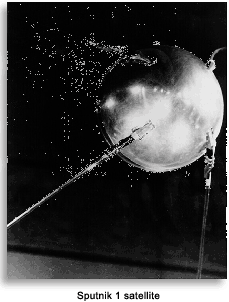On October 4, 1957, the Soviet Union launched Sputnik, the first man-made object to orbit the Earth. In a single stroke, this 184-pound object brought into question the United States' pre-eminence in science, industry, and military power.
 Sputnik, meaning "satellite" and roughly translated as "fellow traveler," was launched by an R7 Semiorka rocket. The rocket was launched from Tyuratam near Baikonur in Kazakstan, at that time part of the Soviet Union and now an independent country.
Sputnik broadcast beeps back to Earth for 23 days until its batteries ran down. It remained in earth orbit until January 4, 1958, when it burned up on re-entry into the Earth's atmosphere. During its initial orbits, its apogee, which is the point of its orbit that is the farthest from the Earth, was 588 miles, and its perigee, which is the point of its orbit that is the closest to the Earth, was 142 miles. Its speed, during each 96-minute orbit, ranged from 16,200 mph at apogee to 18,000 mph at perigee. The principal scientific purpose for this flight was to study the density of the upper atmosphere. By sending the regularly spaced beeps, Sputnik could be positioned with great accuracy, providing information on the atmosphere, which was impeding it.
During the late summer, the Soviets had announced that a long-distance Intercontinental Ballistic Missile (ICBM) had successfully been tested to an altitude of 815 miles and a speed of 13,700 mph. The estimated range of this missile was 5,000 miles. During this period, the United States had experienced two failures in tests of its own Atlas ICBMs. Not having witnessed the Soviet test, the U.S. was quick to suggest that the claim was unlikely. The Atlas ICBM, with its guidance system, was designed to launch a nuclear payload from Texas to nearly anywhere in the Soviet Union and helped propel the rapid acceleration of the Cold War nuclear arms race.
Sputnik, meaning "satellite" and roughly translated as "fellow traveler," was launched by an R7 Semiorka rocket. The rocket was launched from Tyuratam near Baikonur in Kazakstan, at that time part of the Soviet Union and now an independent country.
Sputnik broadcast beeps back to Earth for 23 days until its batteries ran down. It remained in earth orbit until January 4, 1958, when it burned up on re-entry into the Earth's atmosphere. During its initial orbits, its apogee, which is the point of its orbit that is the farthest from the Earth, was 588 miles, and its perigee, which is the point of its orbit that is the closest to the Earth, was 142 miles. Its speed, during each 96-minute orbit, ranged from 16,200 mph at apogee to 18,000 mph at perigee. The principal scientific purpose for this flight was to study the density of the upper atmosphere. By sending the regularly spaced beeps, Sputnik could be positioned with great accuracy, providing information on the atmosphere, which was impeding it.
During the late summer, the Soviets had announced that a long-distance Intercontinental Ballistic Missile (ICBM) had successfully been tested to an altitude of 815 miles and a speed of 13,700 mph. The estimated range of this missile was 5,000 miles. During this period, the United States had experienced two failures in tests of its own Atlas ICBMs. Not having witnessed the Soviet test, the U.S. was quick to suggest that the claim was unlikely. The Atlas ICBM, with its guidance system, was designed to launch a nuclear payload from Texas to nearly anywhere in the Soviet Union and helped propel the rapid acceleration of the Cold War nuclear arms race.
 After October 4, the observable reality of Sputnik, blinking its way across the American sky, made Soviet missile superiority undeniable. Americans were shocked. The famous science fiction writer, Arthur C. Clarke, commented that "As of Saturday, the United States became a second-rate power." The country's most famous rocket scientist, Wernher von Braun, observed that "The Soviet's progress in space is frightening."
One immediate result of Sputnik was a revived interest in science and technology education in the United States. The U.S. Office of Education had just issued a report on the state of American education. It estimated that, in terms of science, the typical Soviet student was as far advanced after 10 years as American students were after 12. as a result of this report, American science education was to more closely involve university researchers in the development of school curricula.
Later Sputnik missions included the 250-pound Sputnik 2, which was launched on November 3, 1957 with the first dog to orbit the Earth, and subsequently Sputnik 3 on May 15, 1958, which boasted a miniature physics laboratory on board.
After October 4, the observable reality of Sputnik, blinking its way across the American sky, made Soviet missile superiority undeniable. Americans were shocked. The famous science fiction writer, Arthur C. Clarke, commented that "As of Saturday, the United States became a second-rate power." The country's most famous rocket scientist, Wernher von Braun, observed that "The Soviet's progress in space is frightening."
One immediate result of Sputnik was a revived interest in science and technology education in the United States. The U.S. Office of Education had just issued a report on the state of American education. It estimated that, in terms of science, the typical Soviet student was as far advanced after 10 years as American students were after 12. as a result of this report, American science education was to more closely involve university researchers in the development of school curricula.
Later Sputnik missions included the 250-pound Sputnik 2, which was launched on November 3, 1957 with the first dog to orbit the Earth, and subsequently Sputnik 3 on May 15, 1958, which boasted a miniature physics laboratory on board.